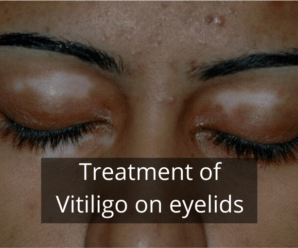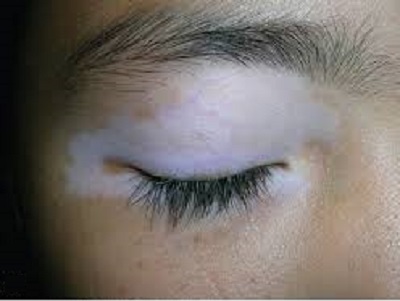
Vitiligo on Eyelids – Treatment options
When vitiligo first appears, the eyelids are one of the most commonly affected body areas because being a part of your face, they are regularly exposed to the sun rays. Also, they are made up of skin folds. If left untreated, vitiligo on the eyelids may spread to cover a large area of the skin around the eyes or even whitening of the eyelashes and eyebrows.

Generally, vitiligo first affects the body parts which are: –
- frequently exposed to the sun, such as face, neck, hands, wrists, elbows and feet.
- body’s natural folds (skin folds) such as armpits, eyelids, groin and genitals
- or the skin area that have been injured in the recent past
Gradually, it may spread over to the other body parts over the course of time.
A Brief overview about Vitiligo
Vitiligo is an autoimmune skin challenge. The faulty and overactive immune system attacks the pigment (color) producing skin cells to cause skin de-pigmentation in the form of white vitiligo lesions on various parts of the body. Vitiligo mainly affects the skin, but in some cases, it may cause premature whitening of hairs also.
The exact cause of autoimmune health issues is not known yet, but the list of most common causes for autoimmunity are: –
- Compromised gut health (chronic indigestion and constipation, lack of health gut microbes, food intolerances, low stomach acid) (1)
- Poor liver health
- Hereditary (faulty genes)
- Chronic emotional stress and anxiety
- Skin damage, such as injuries, sunburn and physical trauma (2)
- Overuse of antibiotics, steroids, certain medications and vaccination
- Infections such as strep throat
- Unhealthy diet, poor lifestyle and lack of sleep
- Alcohol abuse
- Severe nutritional deficiency
- Heavy metal toxicity due to contaminated food, drinking water and polluted environment
Hence, there can be a number of reasons that may trigger your immune system to misfire and cause vitiligo development.
Vitiligo on eyelids – Treatment options
The skin around your eyes is delicate and thinner than the rest of your body. It needs a very careful and sophisticated treatment plan under an experienced health expert to treat vitiligo affecting the skin around your eyes, including the eyelids. Self medication is strictly discouraged as it may even hurt the eyes.
1. Topical medication (external application of creams and ointments)
- Topical corticosteroids (examples are clobetasol, betamethasone and hydrocortisone)
The topical corticosteroids are anti-inflammatory medicines that may suppress the hyper-active immune system to prevent further spreading of vitiligo. In some cases, when applied soon during the initial stages of vitiligo, it may help with skin re-pigmentation, allowing the melanocytes to return, partially or completely. These medications generally take a few months to show results and should be used as part of a long term treatment plan. (3)
The long term use of these corticosteroids is associated with skin thinning and increased skin sensitivity. (4) That’s why, these medications are generally not used for treating vitiligo on sensitive body areas such as eyelids because the skin of the eyelid is already super thin and delicate. The continuous use of these topical medications will make the eyelid skin further thin and we cannot take this risk because eyelids act as protective cover to safeguard the eyes against dryness, excessive strain and foreign matters.
- Topical calcineurin inhibitors (examples are tacrolimus and pimecrolimus)
The topical calcineurin inhibitors are immuno-modulators. They alter the response of the immune system to prevent them from attacking the pigment producing skin cells. These medications are relatively new, costly and not as widely used as the topical corticosteroids.
However, these topicals have less side effects than the corticosteroids. Hence, can be used for long term without much risk of skin thinning. For this reason, calcineurin inhibitors are prescribed for the treatment of vitiligo on sensitive areas such as eyelids, lips and genitals. Some of the side effects associated with these medications are slight burning sensation, skin redness and itching. (5)
2. Photo therapy (UV Light therapy)
As the name suggests, it uses ultraviolet rays- which is found in natural sunlight as well- that has been carefully screened (filtered) to deliver just those wavelengths most useful for skin re-pigmentation. Exposure to these concentrated and focused ultraviolet rays, may stimulate the production of melanocytes in affected areas to prevent vitiligo spreading and to bring back color to the white spots.
The phototherapy is also a long term treatment strategy that requires frequent clinic visits and may take several months to years to show significant results, depending on the severity of the skin condition.
Many of the people with vitiligo try using a portable phototherapy unit that they can use at home. But to treat sensitive areas such as eyelids, it is highly recommended to undergo light therapy under medical supervision only. Otherwise the chances of side effects such as sunburn-like reaction due to excessive exposure or skin irritation would be pretty high. Also, we cannot deny the chances of penetration of UV rays in harmful ranges which may ultimately affect the eyes. (6)
3. Alternative treatment
Most of the alternative treatment options such as Ayurveda work on the principle that Vitiligo is an internal body related problem and the vitiligo spots on the skin are just a manifesto of the fact the inner body matters are not in order. For long term, stable improvement, these treatments focus on improving the gut health (digestive health); rightly so because vitiligo is an autoimmune skin issue and more than 70-75% of the immune system cells are located in the human gut. (7)
In alternative treatments, adopting a healthy and positive diet and lifestyle is considered as important as taking the prescribed medications. Proper sleep, a regular daily routine with fixed meal timings, daily practice of stress relieving techniques like yoga, pranayam and moderate physical exercise– everything is important. Many of the alternative medicine experts recommend consuming anti-inflammatory, gut healing herbs and dietary supplements such as vitamin D, essential Omega 3 fatty acids, turmeric (curcumin), milk thistle, neem, probiotics, glutamine, vitamin b12 and zinc.
Preventive measures and precautions
If you have got vitiligo patches on any other part of your body, especially your face and feel to be at greater risk of vitiligo affecting your eyelids also; or vitiligo has just appeared on the eyelids, then do consider the below preventive and precautionary measures: –
- Protection against physical trauma or irritation– Protect the delicate eyelid skin from any sort of skin trauma, injury or irritation as it may trigger vitiligo. Hence, avoid rubbing your eyes too often or too harsh. Also, during eyebrow waxing/threading, be cautious not to put strain on your eyelid skin.
- Safeguard against exposure to artificial chemicals– The artificial chemicals are a well known trigger for vitiligo. (8) The faulty immune system can mistakenly consider many of these chemicals as a threat and trigger autoimmune response. Hence, avoid the chemical-laden hygiene and cosmetic products that you may be applying to your eyelid skin. For example- facial soap bar, face wash, eye creams, etc. Use natural (herbal) products instead which are relatively mild in nature.



Looking forward for getting enlightened